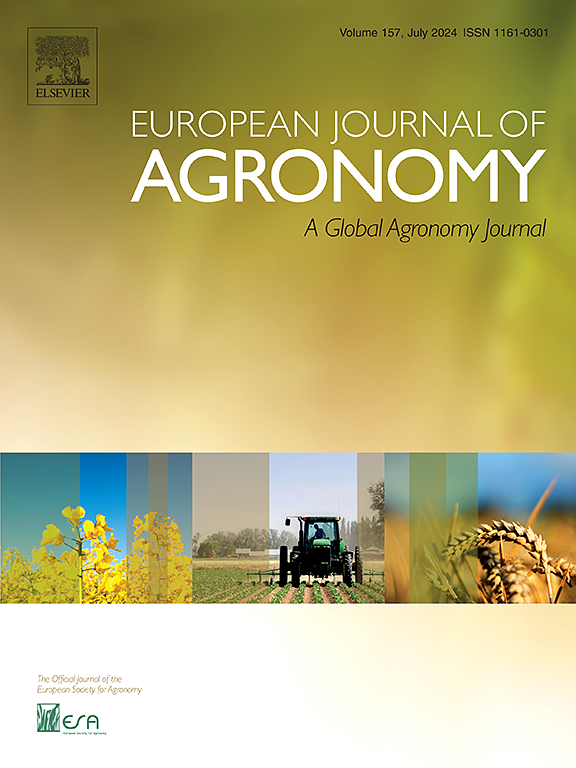在阴影中增产:通过优化源-汇碳分配减轻玉米因阴影引起的产量损失
IF 4.5
1区 农林科学
Q1 AGRONOMY
引用次数: 0
摘要
全球太阳辐射不断减少,降低了光同化作用,破坏了玉米等作物的碳(C)分配,从而对粮食安全构成了巨大威胁。然而,目前还缺乏应对周期性遮光胁迫下源汇平衡的实用对策。在此,我们首先模拟了不同程度和不同时期的遮光胁迫对大田玉米造成的影响。结果证实,遮光导致的产量损失在吐丝前后最为严重,并且与生物量分配密切相关,这意味着在吐丝期间源:汇碳分配严重失衡。为了减轻遮光造成的产量损失,在两季中,分别针对两个吸收汇组织(穗和穗)采用了脱穗(Det)和同步授粉(SP)措施,在吐丝期遮光率达到 70%。两种方法都对谷粒数量和产量产生了益处,遮光下的最终产量增加了 4.0% 至 31.3%。通过 13C 标记、糖代谢测定和全局分析,我们证明了 Det 可通过增加冠层内的光辐照度和消除顶端优势来改善源汇平衡,从而促进 C 同化物分配到果穗中。SP 则通过增加生殖汇强度和优化同化物在籽粒兄弟姐妹间的分配来促进穗内的碳分配。有趣的是,在正常光照条件下,Det 和 SP 也能带来边际增产。我们的研究结果强调了源汇协调和碳分配在减轻玉米在遮光等环境胁迫下的产量损失方面的潜力。这项研究还为通过抽穗和吐丝调控制定农艺实践和育种策略提供了新途径,旨在提高玉米作物产量和抗逆性,确保气候变化下的粮食安全。本文章由计算机程序翻译,如有差异,请以英文原文为准。
Yield more in the shadow: Mitigating shading-induced yield penalty of maize via optimizing source-sink carbon partitioning
Global solar radiation has been decreasing, posing a great threat to food security by reducing photo-assimilation and disrupting carbon (C) partitioning in crops like maize. However, practical countermeasures to cope with source-sink balance in periodic shading stress are lacking. Here, we first simulated shading stresses with different degrees and occurring periods on field maize for two years. Results verified that shading-induced yield penalties are most severe around silking and are closely associated with biomass allocation, implying a significant imbalance of source: sink C partitioning during silking. To mitigate yield losses from shading, detasseling (Det) and synchronous pollination (SP), targeting the two sink tissues (tassel and ear, respectively), were applied to 70 % shading at the silking stage in two seasons. Both practices conferred benefits to grain number and yield production, with final yield increases ranging from 4.0 % to 31.3 % under shading. Through 13C labeling, sugar metabolism assay and global analysis, we proved that Det improved the source-sink balance via increasing light irradiance within the canopy and eliminating apical dominance to stimulate C assimilates partitioning into the ear. SP promoted C partitioning into the ear by increasing reproductive sink strength and optimizing assimilates allocation among grain siblings. Intriguingly, Det and SP also provided marginal yield increase under normal light conditions. Our findings underscore the potential of source-sink coordination and C partitioning in mitigating maize yield penalty under environmental stresses like shading. The research also provides new avenues for developing agronomic practices and breeding strategies via tasseling and silking regulation, aiming to improve maize crop production and stress resilience and ensure food security in the face of climate change.
求助全文
通过发布文献求助,成功后即可免费获取论文全文。
去求助
来源期刊

European Journal of Agronomy
农林科学-农艺学
CiteScore
8.30
自引率
7.70%
发文量
187
审稿时长
4.5 months
期刊介绍:
The European Journal of Agronomy, the official journal of the European Society for Agronomy, publishes original research papers reporting experimental and theoretical contributions to field-based agronomy and crop science. The journal will consider research at the field level for agricultural, horticultural and tree crops, that uses comprehensive and explanatory approaches. The EJA covers the following topics:
crop physiology
crop production and management including irrigation, fertilization and soil management
agroclimatology and modelling
plant-soil relationships
crop quality and post-harvest physiology
farming and cropping systems
agroecosystems and the environment
crop-weed interactions and management
organic farming
horticultural crops
papers from the European Society for Agronomy bi-annual meetings
In determining the suitability of submitted articles for publication, particular scrutiny is placed on the degree of novelty and significance of the research and the extent to which it adds to existing knowledge in agronomy.
 求助内容:
求助内容: 应助结果提醒方式:
应助结果提醒方式:


